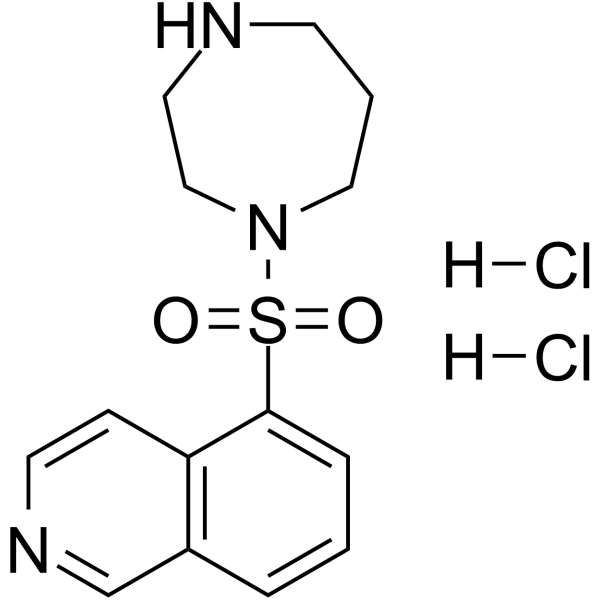203911-27-7
| Name | 1-(5-Isoquinolinylsulfonyl)homopiperazine dihydrochloride, Fasudil dihydrochloride |
|---|---|
| Synonyms |
HA-1077 (hydrochloride)
Fasudil dihydrochloride 5-(1,4-Diazepan-1-ylsulfonyl)isoquinoline dihydrochloride hydrate HA-1077 dihydrochloride Isoquinoline, 5-[(hexahydro-1H-1,4-diazepin-1-yl)sulfonyl]-, hydrochloride, hydrate (1:2:1) HA-1077 dihydrochloride,1-(5-Isoquinolinylsulfonyl)homopiperazine dihydrochloride,Fasudil dihydrochloride |
| Description | Fasudil (HA-1077; AT877) dihydrochloride is a nonspecific RhoA/ROCK inhibitor and also has inhibitory effect on protein kinases, with an Ki of 0.33 μM for ROCK1, IC50s of 0.158 μM and 4.58 μM, 12.30 μM, 1.650 μM for ROCK2 and PKA, PKC, PKG, respectively. Fasudil dihydrochloride is also a potent Ca2+ channel antagonist and vasodilator[1][2][3]. |
|---|---|
| Related Catalog | |
| Target |
PKA:4.58 μM (IC50) PKC:12.3 μM (IC50) p160ROCK:0.33 μM (Ki) ROCK2:0.158 μM (IC50) PKG:1.65 μM (IC50) |
| In Vitro | Fasudil dihydrochloride (100 μM) inhibits cell spreading, the formation of stress fibers, and expression of α-SMA with concomitant suppression of cell growth in rat HSCs (hepatic stellate cells) and human HSC-derived TWNT-4 cells[4]. Fasudil dihydrochloride (50-100 μM; 24 hours) inhibits the LPA (lysophoaphatidic acid)-induced phosphorylation of ERK1/2, JNK, and p38 detected by western blotting in rat HSCs and human HSC-derived TWNT-4 cells[4]. Fasudil dihydrochloride (25-100 μM; 24 hours) suppresses transcription of collagen and TIMP, stimulates transcription of MMP-1 in human HSC-derived TWNT-4 cells[4]. Western Blot Analysis[4] Cell Line: Rat HSCs and human HSC-derived TWNT-4 cells Concentration: 50 μM; 100 μM Incubation Time: 24 hours Result: Suppressed the LPA-induced phosphorylation of ERK1/2, JNK and p38 MAPK by 60%, 70%,and 90%, respectively. RT-PCR[4] Cell Line: Rat HSCs and human HSC-derived TWNT-4 cells Concentration: 25 μM; 50 μM; 100 μM Incubation Time: 24 hours Result: Reduced the expression of type I collagen, a-SMA, and TIMP-1. |
| In Vivo | Fasudil dihydrochloride (10 mg/kg; i.v.; 1 h before operation) exhibits protectable effects on cardiovascular disease and reduces the activation of JNK and attenuates mitochondrial-nuclear translocation of AIF under ischemic injury[5]. Fasudil dihydrochloride (50 mg/kg/d; i.p.) inhibits acute and relapsing EAE (experimental autoimmune encephalomyelitis) induced by proteolipid protein PLP p139-151, reduces lymphocytes proliferation, results downregulation of interleukin (IL)-17 and a marked decrease of the IFN-γ/IL-4 ratio[6]. Fasudil dihydrochloride (100 mg/kg/d; p.o.) significantly reduces incidence and pathological examination score of EAE (experimental autoimmune encephalomyelitis) in SJL/J mice, decreases inflammation, demyelination, axonal loss and APP positivein spinal cord in mice[6]. Animal Model: Myocardial ischemia and reperfusion in rat (250-300 g)[5] Dosage: 10 mg/kg Administration: Intravenous injection; 1 h before operation Result: Activated the Rho-kinase, JNK, and resulted AIF translocated to the nucleus. Inhibited Rho-kinase activity, and reduced myocardial infarct size and heart cell apoptosis. |
| References |
| Molecular Formula | C14H21Cl2N3O3S |
|---|---|
| Molecular Weight | 382.306 |
| Exact Mass | 381.068054 |
| PSA | 79.91000 |
| LogP | 4.10600 |
| Personal Protective Equipment | Eyeshields;Gloves;type N95 (US);type P1 (EN143) respirator filter |
|---|---|
| RIDADR | NONH for all modes of transport |
| RTECS | HM4031166 |
| HS Code | 2942000000 |
| HS Code | 2942000000 |
|---|
